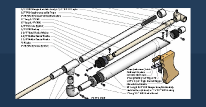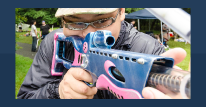This is sort of outdated, but worth looking at.
The Unholy3's Guide to Dart Making
Your blaster will perform only as good as your darts are. Being a good dartsmith takes time and practice. I will help explain how to make the process easier. This guide will cover every aspect of what we call "stefans", or homemade Nerf darts.
Choosing your foam
There are many types of foam backer rod available over the internet, and also at your local hardware store. It should be noted that foam is fairly inconsistent from batch to batch. The foam's diameter will vary depending on your geographical location, temperature, humidity, the factor of how much it actually varies, etc. Always fit your barrels to your foam if you can. You generally want tight fit for "springers", and a loose fit for "airguns". More information on specific barrel materials can be found here.
Rather than listing several types of foam that can be used, there are a few things you should consider when purchasing foam.
- Density: The more dense, generally the better. Darts are much easier to make when you have foam that isn't too squishy, especially if you're burning or drilling a hole for a weight. The foam shouldn't deform when rolling it around in your fingers a few times. If it does deform easily, you're probably going to want to get different foam.
- Price: Foam backer rod can vary in price depending on the manufacturer and how much foam is being purchased. For example: Ace Hardware's brand 1/2" FBR is approximately $6.00 to $6.50 for 20', or ~$0.30-$0.33 per foot. This is generally expensive per foot. When you buy small quantities, you're going to be paying more per foot. If you want your own custom foam from China, it's likely going to cost you thousands.
- Amount: How much will you need? If you attend only a handful of nerf wars a year, you can probably get by on buying foam in small quantities from your local hardware store. If you plan on attending more than that, you might want to consider purchasing some foam off the internet. A good bet is always McMaster-Carr's foam. It's roughly $36 for 250' (#93295K43). This can vary a lot though. If you live near a warehouse they'll let you swap it out for a different roll when you pick it up at Will Call. If you're seeking larger amounts, there are a few sites that sell several hundred feet. I will most likely post a thread for foam availability at some point.
- Color: Most FBR is colored gray or black. This isn't ideal for our purposes, but makes sense for it's actual intended use. Finding colored foam can be difficult. You're on your own here.
- Type: You must make sure you're buying closed-cell foam. Open celled doesn't make very good darts.
Heating and/or stretching your foam
Since FBR is normally packaged in rolls or spools, you'll also need to make it straight. There is supposedly some debate that foam cannot be stretched. This may be partially true, but I know I have done it successfully.
- Heating: When heating foam, the diameter of the foam will slightly expand in the process. This will depend on how long you heat it, and the composition of the foam (i.e. some foam heats differently than others). The easiest way to heat it, is to cut up all your dart blanks first. Take all of the blanks and throw them into a pillowcase. Loosely tie a knot on the end so the darts will remain in the pillowcase. Throw the pillowcase in the dryer. Heat it on "low" for 5-10 minutes. Leave it in until you're darts are nice and straight. The foam is increased in diameter slightly after it's been heated. An alternative method is using a hair dryer, instead of your regular dryer. I find that the regular dryer heats the foam a lot more evenly than using a blow dryer.
- Stretching: There are probably several methods to stretching foam. I know at least this one works. Cut your foam into rough 8' segments (or however high your ceiling is) and weight them at one end. Suspend the other end from your ceiling and let sit for several days or weeks. You can adjust how much you need it to stretch by adding more or less weight to the one end of the foam. You'll have to do trial and error until you get the perfect fit.
Cutting dart blanks
There is one very simple way to make perfect, square cuts every time. Get a piece of tubing that has a loose fit on your foam. You're going to want to be able to feed your foam through it. Cut a slit in the tubing the goes almost all the way through the tubing. You want to use something that has rather thick walls so the blank template doesn't fall apart. Sch. 80 works great for the most common sized foam. If you don't cut the slit deep enough, your foam won't be cut all the way. You'll cut the slit however long you want your darts to be from the end of the tube. Use a generous amount of tubing for the template so you have a place to put you're hand when cutting. De-burr the inside of the blank template with some sandpaper wrapped around something that will fit inside the blank template. Now that you're template is done, feed the foam into the end of the pipe furthest away from the slit. Feed until it's flush with the other end of the tube. With a razor blade, cut through the slit. You want to make sure the razor blade is sharp, so the cuts are clean. Feed the foam through again and repeat.
You could also cut multiple slots if you wanted to make them faster. Use a mitre box to cut the slit for the template, or something that can cut square. This will ensure nice, square cuts, or at least good enough.
Weighting your darts
There are many options to what you can use for the tip of your dart. Please note that glue domes are pretty much banned at any major war, which three of these weights usually use. More will be explained on that. The weight you use will be dependent on a number of things. If you plan on using these on people, or at a war, check to make sure what is allowed and what isn't. Dart weight will also depend on what blaster you plan on using them in. If you're using a relatively heavy dart in a low powered blaster, you're range may be reduced. Here's a test I did not to long ago further explaining the correlation of dart weight to blaster performance. Here's a list of some common weights that are both no longer used, and what is now being used:
- 1/4" Slingshot weights: The heaviest used weights for dart making. These can become dangerous in high powered blaster. The increased weight will increase range on high powered blaster dramatically, and decrease range in lower powered blasters. I would not use these for shooting other people. Since they are round, and half the diameter of the foam, they are very easy to center in the foam. Cost per weight is around $0.01-$0.02 per weight. These are banned at almost every current war.
- Felt disc + washers(Slugs): Also known as Slug darts, they consist of a felt pad with a washer sandwiched between the felt and the foam. The felt and washers are sold through McMaster (see this thread on how to make them the right way). They are very easy to make and also faster to make than traditional stefans. Cost per dart head is roughly $0.02-$0.03. These are currently the most popular form of darts used across the country.
- BB's: Lightest of the four. Hard to center in foam, but work relatively better with lowered powered blasters. Some people will often use two BBs, but this is also very difficult to center the weights. BB's also vary in weight, from ~0.30 grams to ~0.45 grams. These are the cheapest weights, which usually cost less than half a cent per weight.
- Fishing weights: Haven't had too much experience with these. They are somewhere in weight between 1/4" slingshot ammo, and slug darts. They aren't desirable weights because they aren't spherical, which can be difficult to make the weight centered. I'd stay away from these if possible.
- Non-metal: A lot of people are trying to create something non-metal, but soft enough that could be a viable weight for a new generation of darts. There are lots of experimental darts that have been or still are being developed in the last year especially.
Gluing your darts
- Felt Disc + Washer - More information can be found about this in this guide. Slugs can be very durable if made properly.
- Traditional hot glue domes* - Making perfect domes takes time and practice. When you make a traditional dome, you're securing the weight in the foam. This is as equally important as the dome. Making centered holes takes time and practice. You can either burn your holes with the hot glue gun, or a soldering iron also works quite well. It's imperative to the darts accuracy that the hole is centered. The hole should be deep enough to hold the weight slightly under the top of the foam. Fill the top with hot glue. When you're pulling away the glue gun from the foam, turn the glue gun in a couple circles. This will help the shape of your dome, and prevent small hot glue strands everywhere. Let the hot glue sit and form into a dome. You can move the dart around to get the glue to settle how you want it to. When the dome is perfectly spherical, drop it upside down in a bath of cold water. This will solidify the hot glue very quickly and keep your perfect dome intact. Ice9 and I have used this technique to make domes as good as these.
You'll want to use a low temperature hot glue gun. High temp guns usually deform the foam and cause you to make shitty darts. It's easier to use the smaller ones too.
*These darts are banned almost everywhere, except for the lost nerfing communities that can't change with the times.
Miscellaneous
The next step is finding the proper barrel material for your darts. Fortunately for you, I have already done that.
Barrel Material Guide
Good dart-making takes patience, time, and effort. This is mostly outdated but still has some important stuff.
=========================================================
Updated 07/26/12
Edited by Ryan201821, 26 July 2012 - 03:52 PM.










